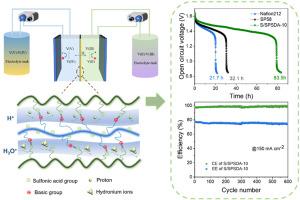An improved conductive SPEEK composite membrane for vanadium flow battery enabled by comb-like amphoteric maleic anhydride polymer
IF 9
1区 工程技术
Q1 ENGINEERING, CHEMICAL
引用次数: 0
Abstract
In this work, we report a series of composite membranes (S/SPSDA) with sulfonated poly(ether ether ketone) (SPEEK) as membrane matrix and amphoteric comb-like SPSDA polymer as a structural modifier (SPSDA), synthesized from the ring-opening process of maleic anhydride of poly(styrene-co-maleic anhydride) (SMA) by grafting 2,4-diaminobenzene sulfonic acid (DABSA) on the SMA skeleton, by a simple solution-blending method. With various contents of SPSDA from 5 % to 20 wt%, the S/SPSDA membranes exhibit excellent physicochemical properties involving conductivity and selectivity owing to their formed interfacial interactions and cooperative main-/side-chain proton transportation channel, and the S/SPSDA-10 membrane displays significantly reduced vanadium ion permeability (15.5 × 10−7 cm2 min−1) and enhanced proton conductivity (31.9 mS cm−1) compared to SPEEK and Nafion 212. Furthermore, higher coulombic efficiency (CE: 97.5–99.3 %) and energy efficiency (EE: 83.0–68.5 %) at 100–200 mA cm−2 current densities, 600 charge-discharge cycles at 150 mA cm−2 with 98.0 % CE and 76.0 % EE, as well as longer self-discharge time of 83.5 h demonstrate better operation stability and durability of the S/SPSDA-10 membrane with superior proton transport capability and vanadium ion resistance. In addition, a 33 % charging capacity retention rate at the first 100 cycles and increased chemical stability elucidate a satisfactory permeability-conductivity tradeoff effect, indicating that amphoteric comb-like SPSDA polymer affords the structural stability and the construction of proton network by assembling strong acid-base interaction and main-/side-chain bi-sulfonated transport channels. Thus, manipulating the main-/side-chain topological structure in a comb-like polymer offers a facile method to explore and develop high-performance composite membranes for achieving long-term and highly efficient electrochemical energy storage applications.

一种由梳状两性马来酸酐聚合物制成的钒液流电池用改进型导电SPEEK复合膜
本文报道了以磺化聚醚醚酮(SPEEK)为膜基质,以两性梳状SPSDA聚合物为结构改进剂(SPSDA),在聚苯乙烯-共聚马来酸酐(SMA)骨架上接枝2,4-二氨基苯磺酸(DABSA),采用简单的溶液共混法,将聚苯乙烯-共马来酸酐(SMA)的开环工艺合成了一系列复合膜(S/SPSDA)。当SPSDA含量在5% ~ 20%之间时,S/SPSDA膜表现出优异的电导率和选择性,这主要是由于其形成的界面相互作用和主/侧链质子传输通道,与SPEEK和Nafion 212相比,S/SPSDA-10膜的钒离子渗透性显著降低(15.5 × 10−7 cm2 min−1),质子电导率显著提高(31.9 mS cm−1)。此外,在100-200 mA cm - 2电流密度下具有较高的库伦效率(CE: 97.5 - 99.3%)和能量效率(EE: 83.0 - 68.5%),在150 mA cm - 2电流密度下具有600次充放电循环,CE为98.0%,EE为76.0%,自放电时间为83.5 h,表明S/SPSDA-10膜具有良好的质子传输能力和抗钒离子能力,具有良好的运行稳定性和耐久性。此外,在前100次循环中,33%的充电容量保持率和增加的化学稳定性说明了令人满意的渗透-电导率平衡效应,表明两性梳状SPSDA聚合物通过组装强酸碱相互作用和主/侧链双磺化运输通道,提供了结构稳定性和质子网络的构建。因此,操纵梳状聚合物的主/侧链拓扑结构为探索和开发高性能复合膜提供了一种简便的方法,从而实现长期高效的电化学储能应用。
本文章由计算机程序翻译,如有差异,请以英文原文为准。
求助全文
约1分钟内获得全文
求助全文
来源期刊

Journal of Membrane Science
工程技术-高分子科学
CiteScore
17.10
自引率
17.90%
发文量
1031
审稿时长
2.5 months
期刊介绍:
The Journal of Membrane Science is a publication that focuses on membrane systems and is aimed at academic and industrial chemists, chemical engineers, materials scientists, and membranologists. It publishes original research and reviews on various aspects of membrane transport, membrane formation/structure, fouling, module/process design, and processes/applications. The journal primarily focuses on the structure, function, and performance of non-biological membranes but also includes papers that relate to biological membranes. The Journal of Membrane Science publishes Full Text Papers, State-of-the-Art Reviews, Letters to the Editor, and Perspectives.
 求助内容:
求助内容: 应助结果提醒方式:
应助结果提醒方式:


